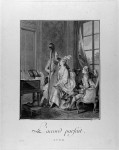
L’accord Parfait, or Perfect Harmony is an engraving from the second set of Jean-Michel Moreau le Jeune’s collection Monument du Costume – a collection of engravings created and set in Pre-Revolution France. This piece complements the rest of Moreau’s collection by highlighting the moral and material excesses of the French aristocracy. The ironic title sheds light on the potential infidelity taking place between the young woman in the picture and her music instructor as he lightly guides her fingers across the harp. The snapshot perfectly expresses the idea of disunity within the false unity of a seemingly happy marriage – the woman’s husband looks on blithely; apparently unaware and unconcerned with the instructor’s intentions.
Moreau was a prolific printmaker in the later part of the 18th century – having created over 4000 prints for a variety of patrons ranging from nobility to middle class citizens. There is some debate over which pieces in Monument du Costume are actually Moreau’s and which were done by those who collaborated with him. Most historians now believe that the complete collection was not conceived as a whole by Moreau but rather was put together after the individual pieces were created.[i] In addition, there is some debate on the meaning or themes of the pieces – were Moreau’s depiction satirical and ironic or a sincere idealized view of upper class life in France during the 18th century. The former certainly seems more likely when viewing L’accord Parfait; the closeness of the instructor to the woman brings about thoughts of infidelity in most viewers. It is interesting however, that when looking at art critics of Moreau’s time his works were described as “sincere.”[ii] It is only a century later and the change of perspective that it brought that critics began to suggest that Moreau’s engravings were actually critical instead of praising of the subjects he depicted. [iii]
This background on Monument du Costume presents two different narratives on the meaning and intent of the engraving L’accord Parfait. The positive view expresses the scene as a genuinely serene and “perfect” moment in the lives of a happy couple in the aristocracy. The negative view expresses the scene as the beginnings (or perhaps the continuation of) a scandalous affair. The negative view also is critical the French aristocracy in itself – how could these people live such luxurious and privileged lives when their subjects were starving a few miles away? Both interpretations, although polar opposites, can be seen within the context of the interactions of unity and disunity. Unity is expressed in the way the husband is depicted looking on happily as his wife plays on the harp with the help of her instructor. Disunity is expressed in both the historical context of this piece (the French commoner could scarcely dream of such a life) and in the thought of infidelity between the wife and the instructor. The potential attraction between the woman and the instructor is subtle, but it is hard to view the piece without being reminded of it.
Moreau himself has nothing to say on the piece of particular interest, in his catalogue raisonne he only mentions the physical characteristics of the piece: “there is a young man sitting in the corner…there is a young woman playing the harp…there is a dog on the floor…[iv] Thus, the true meaning is the viewer’s to determine. What is clear, however, is that like in so many other aspects of society, disunity is hiding within the apparent unity of this piece. Whether that disunity is simply the contrast between what is being depicted and the situations being faced by the French commoners at this time, or if it is indeed, as many suspect, a depiction of an affair in progress remains to be seen.
BK
[i] Moreau le Jeune and the Monument du Costume. by Bernadine Heller-Greenman.
[ii] Graphic Art of the Eighteenth Century by Jean Adhémar
[iii] Moreau le Jeune and the Monument du Costume. by Bernadine Heller-Greenman.
[iv] L’oeuvre de Moreau le jeune ; catalogue raisonne by Marie Joseph and François Mahérault